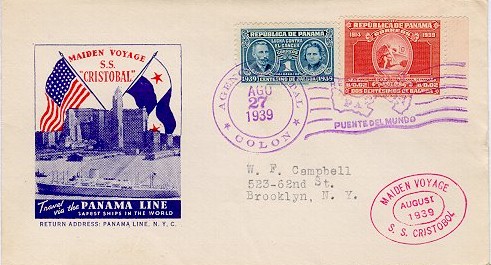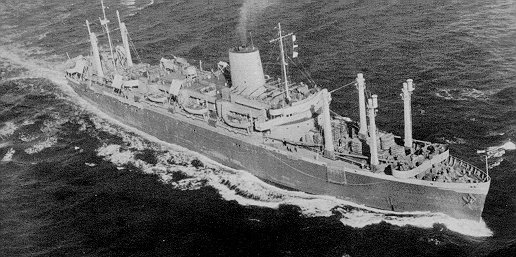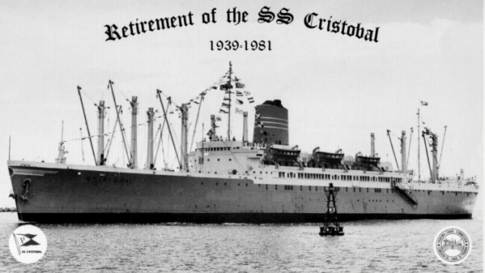


The US Army Transport Cristobal embarked the 20th Engineer Regiment at New York on 1 November 1942, then sailed on 2 November. The Cristobal transported the regiment to its first campaign in North Africa, landing in Casablanca on 19 November.
One of three sister ships constructed for the Panama Canal's Panama Line by the Shipbuilding Division of Bethlehem Steel in Quincy, Mass, the S. S. Cristobal was launched March 4, 1939, and sailed out of New York on her maiden voyage to Panama the following August 17.Ê

The S.S. Cristobal was requisitioned from the Panama Railroad Company by the U.S. Army on January 11, 1942 and was redesignated the US Army Transport Cristobal (USAT Cristobal). Twelve days later -- her trim lines muddled with camouflage paint, and partially converted so every valuable inch could be utilized -- the Cristobal sailed from New York with troops and supplies bound for New Caledonia. However, political relations between the Free French, the Vichy French and the United States were not yet clear, so the convoy with which the Cristobal was traveling was diverted to Australia. There the ship reloaded, picked up field artillery guns and proceeded to New Caledonia.
Arriving at Noumea, New Caledonia, the first part of March, 1942, the troops disembarked by using the ship's lifeboats. For days, these troops sweated over the unfamiliar and back-breaking job of handling all cargo by hand. There were no facilities ashore at New Caledonia. Our war was three months old.
The Cristobal was next ordered back to New York. As she drew near the Atlantic Coast, there was no rest for the officers and crew. The coastal waters were known to be infested with enemy submarines. None was spotted until the Cristobal was off Cape Hatteras. There the dark dripping snout of an emerging sub was sighted. She hulked out of the water as the men on the Cristobal waited tensely. The men on the submarine were evidently just as amazed at finding an enemy ship so close by, and the submarine submerged.
Back in New York the Cristobal was further converted to carry 2,300 troops. She next headed for Belfast, Ireland. Then, on to Scotland for British troops, and to join a convoy of British and American ships. On Memorial Day, 1942, the Cristobal sailed fur Suez. The long voyage, via Freetown, West Africa; Capetown and Durban, South Africa; and Aden, Arabia, was made safely, and the Cristobal reached Suez July 23, 1942. Once there, her days seemed numbered, for she was exposed nightly to fierce air attack, particularly from the ships' deadly enemy, the torpedo plane.
However, the Cristobal's luck held, and the gallant ship started the long trip home unscathed. On this trip, her passengers were Italian prisoners of war from North Africa bound for Durban. And this time she sailed without military escort. Thirty-one days later the men on the Cristobal thankfully eased the ship into New York Harbor, having stopped for only one day in Durban, where the Italian prisoners disembarked, and one day in Capetown to pick up fuel oil.

The USAT Cristobal at Sea in WW2
At the end of October,
1942, the 20th Engineer Regiment embarked upon the Cristobal and the vessel left New York again -- destination unknown. After several days at sea the captain was directed to transport the troops to French Morocco for the invasion of Casablanca. After debarking the 20th Engineers pierside, in the space of eleven days the Cristobal
was filled with wounded service men from action at Casablanca ... 1,300 of them ... who were brought
back to New York.
For the duration of the war in Europe, the Cristobal made trips back and forth to
the Mediterranean, North Africa and Italy with occasional trips to England and Iceland.
After the invasion of Normandy, she landed elements of the 104th Infantry Division on 7 September 1944 at Utah Beach, and other units later at Le
Havre, France; Marseilles, France; and Port Said, Eqypt, the Mediterranean entrance of the Suez Canal. On 30 March 1945, in the North Atlantic, the Cristobal collided with an Allied tanker ship, the Crow Wing. Both ships were damaged, but continued with their missions.
When the European conflict ended, the Cristobal brought back troops from
Italy, France and England. She carried a great many sick and wounded, being
particularly well fitted for use as a hospital ship.
In January, 1946, the ship underwent another partial conversion -- this time for the
comfort of the bride and diaper trade. The Cristobal carried a vast number
of war brides and children from England, France, and Port Said without a single casualty.
By the time she made her last war-service voyage, the stately Cristobal
was quite used to the maze of diapers and dainties hanging everywhere. On her last
trip she carried American dependents to Bremerhaven, Germany, and returned with war brides
from France and England.
After completing 4 years and 5 months service with the Army, on 14 June 1946, the Cristobal was returned to the Panama Line, where she continued passenger/cargo service between New York and Panama until April 1961.Ê In June of that year the Cristobal made her first voyage between New Orleans and Panama, a route she was to ply until her last voyage on September 19, 1981.

Most of the information on this page was taken from CZBrats, a web site dedicated to those who built, maintained, and secured the Panama Canal.